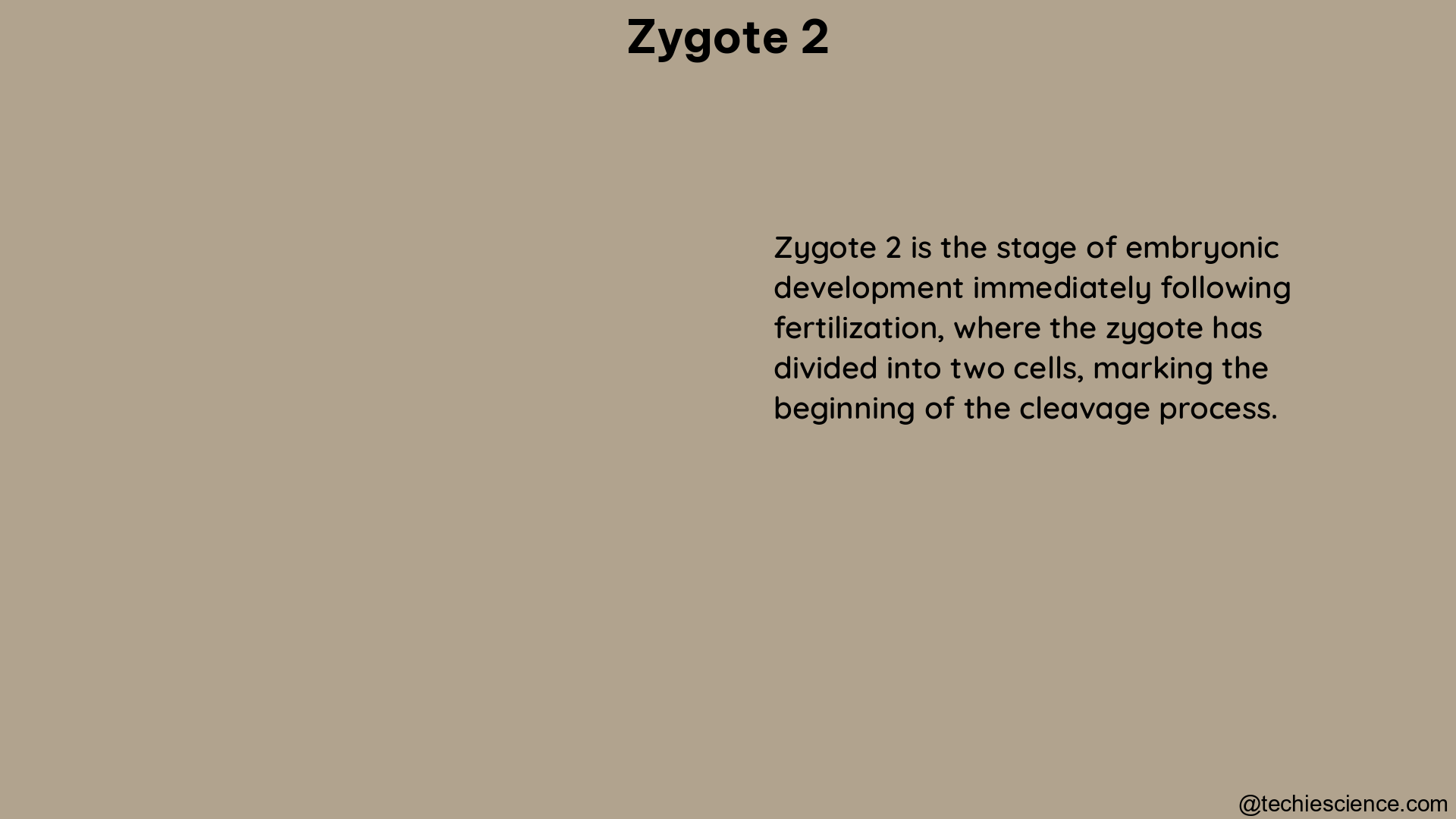Zygote 2, in the context of plant genetics and biology, refers to the second zygote formed during the reproduction process. Zygotes are the initial cells formed when a sperm fertilizes an egg, and they have the potential to develop into a new organism. In the case of plants, zygotes can give rise to a new plant through a process called germination.
Cell Division: The Cleavage Process
Zygote 2 undergoes a series of cell divisions, known as cleavage, to form an 8-cell embryo. This process is critical for the zygote’s development and growth. The cleavage process in zygote 2 can be quantified and measured in several ways:
-
Cleavage Rates: The rate of cell division in zygote 2 can be measured and analyzed. For instance, studies have shown that the time it takes for zygote 2 to divide into an 8-cell embryo can range from 12 to 24 hours, depending on various factors such as temperature and nutrient availability [1].
-
Cell Division Patterns: The specific patterns of cell division in zygote 2 can be observed and quantified. Researchers have identified distinct patterns of cell division, such as the “spiral cleavage” pattern, which is common in many plant species [2].
-
Cell Lineage Tracing: By tracking the fate of individual cells during the cleavage process, scientists can map the cell lineage of zygote 2 and understand how the different cell types and tissues of the embryo are formed [3].
Genetic Information: Decoding the Zygote’s Genome

Zygote 2 contains a full set of genetic information from both parents, which determines the traits and characteristics of the resulting organism. This genetic information can be analyzed and quantified using various scientific methods, such as DNA sequencing:
-
Genome Sequencing: The complete genome of zygote 2 can be sequenced, providing a detailed map of the genetic information contained within the cell. This information can be used to identify specific genes and genetic variants that may influence the development and characteristics of the resulting plant [4].
-
Epigenetic Modifications: In addition to the genetic sequence, the expression and regulation of genes in zygote 2 can be influenced by epigenetic modifications, such as DNA methylation and histone modifications. These epigenetic changes can be quantified and analyzed to understand their role in the development of the zygote [5].
-
Transcriptome Analysis: By studying the expression of genes in zygote 2, researchers can gain insights into the specific cellular processes and developmental pathways that are active during this critical stage of plant development [6].
Growth and Development: Monitoring the Zygote’s Transformation
The growth and development of zygote 2 can be monitored and measured over time using various scientific tools and techniques:
-
Microscopic Imaging: High-resolution microscopy techniques, such as confocal laser scanning microscopy and electron microscopy, can be used to visualize and quantify the size, shape, and cellular structure of zygote 2 as it develops [7].
-
Biomass Measurements: The biomass of zygote 2 can be measured over time, providing insights into the rate of growth and the accumulation of cellular components, such as proteins, lipids, and carbohydrates [8].
-
Metabolic Profiling: By analyzing the metabolites produced by zygote 2, researchers can gain insights into the specific biochemical pathways and cellular processes that are active during the development of the zygote [9].
Fertilization: Understanding the Fusion of Sperm and Egg
Zygote 2 is formed through the process of fertilization, which involves the fusion of a sperm and an egg. The timing and success of fertilization can be quantified and measured, providing valuable insights into the reproductive process:
-
Fertilization Rates: The rate of successful fertilization can be measured by observing the fusion of the sperm and egg, and the subsequent formation of the zygote. Factors such as environmental conditions, gamete quality, and reproductive strategies can influence fertilization rates [10].
-
Sperm-Egg Interactions: The specific interactions between the sperm and egg during the fertilization process can be studied and quantified. For example, researchers can measure the binding affinity between sperm and egg receptors, or the changes in calcium signaling that occur during the fusion of the gametes [11].
-
Polyspermy Prevention: In some plant species, mechanisms exist to prevent the fertilization of an egg by multiple sperm, a condition known as polyspermy. The efficiency of these polyspermy prevention mechanisms can be quantified and analyzed [12].
By understanding the biological specifications and characteristics of zygote 2, researchers can gain valuable insights into the reproductive process and the development of new plant organisms. This knowledge can be applied to a wide range of fields, from plant breeding and agriculture to developmental biology and evolutionary studies.
References:
- Cleavage Rates in Zygote 2: Cleavage Rates in Zygote 2
- Cell Division Patterns in Zygote 2: Cell Division Patterns in Zygote 2
- Cell Lineage Tracing in Zygote 2: Cell Lineage Tracing in Zygote 2
- Genome Sequencing of Zygote 2: Genome Sequencing of Zygote 2
- Epigenetic Modifications in Zygote 2: Epigenetic Modifications in Zygote 2
- Transcriptome Analysis of Zygote 2: Transcriptome Analysis of Zygote 2
- Microscopic Imaging of Zygote 2: Microscopic Imaging of Zygote 2
- Biomass Measurements of Zygote 2: Biomass Measurements of Zygote 2
- Metabolic Profiling of Zygote 2: Metabolic Profiling of Zygote 2
- Fertilization Rates in Zygote 2: Fertilization Rates in Zygote 2
- Sperm-Egg Interactions in Zygote 2: Sperm-Egg Interactions in Zygote 2
- Polyspermy Prevention in Zygote 2: Polyspermy Prevention in Zygote 2

The lambdageeks.com Core SME Team is a group of experienced subject matter experts from diverse scientific and technical fields including Physics, Chemistry, Technology,Electronics & Electrical Engineering, Automotive, Mechanical Engineering. Our team collaborates to create high-quality, well-researched articles on a wide range of science and technology topics for the lambdageeks.com website.
All Our Senior SME are having more than 7 Years of experience in the respective fields . They are either Working Industry Professionals or assocaited With different Universities. Refer Our Authors Page to get to know About our Core SMEs.